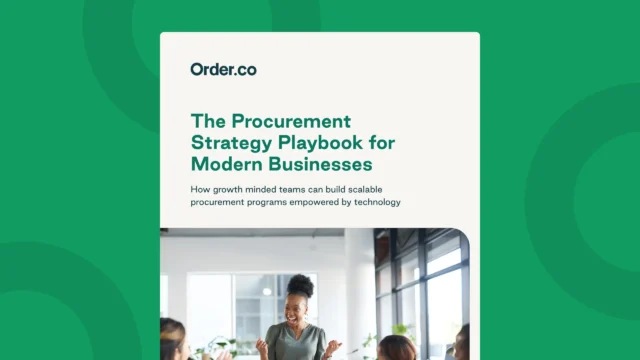The Ultimate Checklist for Evaluating Procurement Integrations with Workday, NetSuite, and Sage Intacct

The Ultimate Checklist for Evaluating Procurement Integrations with Workday, NetSuite, and Sage Intacct
For finance and operations leaders, the promise of automation is only as good as the connection between your systems. When your procurement platform doesn’t properly communicate with your accounting system, you’re left with the very problems you sought to eliminate: manual data entry, the risk of human error, a delayed month-end close, and a frustrating lack of real-time spend visibility. Choosing a procurement solution with a robust integration isn’t just a technical detail—it’s the foundation of an efficient, scalable financial operation.
Selecting the right platform requires looking beyond a simple "yes" on an integration checkbox. The depth, reliability, and automation level of that connection determine its true value. This guide provides a comprehensive checklist to help you evaluate procurement integrations for NetSuite, Workday, and Sage Intacct, ensuring you select a partner that truly streamlines your purchase-to-pay (P2P) process.
Download the free ebook: The Procurement Strategy Playbook for Modern Businesses
Why a deep procurement-to-accounting integration matters
A deep integration automates the entire P2P lifecycle, eliminates manual data entry, provides real-time spend visibility, and accelerates financial closing. It transforms your procurement and accounting systems from siloed databases into a single, cohesive financial engine that drives efficiency and strategic insight.
Without a seamless connection, your team is likely stuck exporting CSV files, manually keying in invoice data, and spending hours reconciling discrepancies between systems. This not only wastes valuable time but also introduces a high risk of error that can lead to inaccurate financial reporting and duplicate payments. A strong integration ensures data flows automatically and accurately, giving you a trusted, single source of truth for all spend-related activity. This frees your team to focus on strategic tasks like budget analysis and vendor negotiations instead of tedious administrative work.
The core integration checklist: What to look for
When evaluating integrations, focus on five key areas: data synchronization points, automation level, implementation and support, scalability for multiple entities, and API accessibility for custom needs. A truly effective solution will deliver positive answers across all these categories, creating a reliable and automated workflow. Use this best-practice procurement integration checklist to guide your conversations with potential vendors.
Data synchronization: What information flows between systems?
A robust integration should sync vendors, purchase orders, receipts, invoices, and payment data automatically, ensuring your accounting system always has up-to-date information. The goal is to create a complete, auditable trail from requisition to payment without manual intervention.
Ask potential vendors to confirm the following data touchpoints:
- Vendors: When a new vendor is approved in the procurement platform, is it automatically created in your ERP? Can you import your existing vendor master list into the procurement platform to ensure consistency from day one? A strong connection prevents duplicate vendor records and keeps supplier information accurate across both systems.
- Purchase Orders (POs): Are approved POs created in the procurement system automatically synced to your ERP? This provides the finance team with immediate visibility into committed spend and upcoming liabilities.
- Item Receipts: Does the platform capture and sync item receipt data? This information is critical for systems that rely on a traditional 3-way match between the PO, invoice, and goods receipt note before an invoice can be paid.
- Invoices and Bills: This is the most critical connection point. Does the integration automatically create a bill in your ERP when an order is fulfilled? The bill should arrive complete with line-level detail and pre-filled GL codes, ready for payment. This eliminates the need for your AP team to manually create bills from paper or PDF invoices.
- Chart of Accounts and Dimensions: The integration must support your full chart of accounts and custom dimensions (also known as segments or tags). It should allow you to map purchases to the correct departments, classes, locations, and projects directly within the procurement platform, ensuring every dollar is categorized correctly before it ever reaches the general ledger.
Automation level: How much manual work is actually eliminated?
The best integrations automate GL coding, bill creation, and reconciliation, requiring minimal human intervention. Be wary of solutions that simply push a PDF of an invoice into your ERP, as this still requires your team to manually code and process it. The goal is to find a system that does the heavy lifting for you.
Here’s what to look for to gauge the true level of automation:
- Automated GL Coding: A key time-saver is the ability to set rules that automatically apply the correct GL codes to purchases at the line-item level. This should happen before the transaction syncs to the ERP, ensuring data arrives clean and correctly categorized. This simple feature can prevent countless hours of manual coding and re-classifications during the month-end close.
- Automated Bill Creation: The platform should create a bill payable in your ERP automatically once an order is fulfilled. The process should be touchless—the data flows from the PO to the bill without anyone on your team needing to intervene. This is a critical step to connect your P2P to your accounting system effectively.
- Simplified Reconciliation: Ask how the system makes reconciliation easier. Does it automatically handle credits from returns or flag discrepancies? A truly advanced platform can fundamentally change your reconciliation process. For example, Order.co’s Consolidated Billing feature groups all your purchases into a single, reconciled invoice, reducing the number of bills your AP team has to process by up to 50x.
Implementation and ongoing support
A smooth integration depends on a clear implementation process and dedicated support. A vendor can promise a perfect integration, but if the setup process is confusing or you can’t get help when a sync error occurs, the tool will quickly become a source of frustration.
Your evaluation should include:
- Implementation Timeline: What is the average time to get the integration up and running? A well-designed, pre-built connector should be configurable in days, not months.
- Dedicated Support: Will you have access to an integration specialist or a dedicated team to guide you through setup? Having an expert who understands both the procurement platform and your ERP is invaluable.
- Error Handling and Visibility: No integration is perfect 100% of the time. Ask what happens when data fails to sync. Is there a clear error dashboard that explains the issue and provides steps for resolution? The system should make it easy to identify and fix sync issues without needing to file a support ticket for every minor problem.
Scalability: Handling multi-entity and location complexity
For growing businesses, the integration must support multiple legal entities, subsidiaries, and locations seamlessly. It should be able to apply the correct dimensions and sync data to the appropriate entity within your ERP without manual workarounds. This is a non-negotiable for companies in retail, healthcare, hospitality, and any other industry with a distributed footprint.
Assess the platform’s scalability with these questions:
- Multi-Entity Support: Can the platform map purchasing from different business locations or departments to distinct entities in NetSuite, Workday, or Sage Intacct? This ensures financial data is correctly segregated for accurate P&L reporting by entity.
- Dimension Mapping: Does the system support custom dimensions and fields that are specific to each entity? This is crucial for granular reporting and budget tracking across your entire organization. A platform that provides a flexible framework for centralized purchasing across multiple entities is essential for scaling.
- Consolidated View: Even with purchasing segregated by entity, can you still get a consolidated, real-time view of spend across the entire organization within the procurement platform? This allows you to leverage your total spend for better negotiations and strategic sourcing.
API access and customization
While pre-built connectors for major ERPs are essential, the best procurement software also offers robust API access for custom integrations. A flexible, well-documented API provides the freedom to build custom workflows or connect other business-critical systems, future-proofing your investment.
- Public API: Does the vendor provide a public, RESTful API for custom development?
- Comprehensive Documentation: Is the API documentation clear, complete, and easy for a developer to use?
- Webhooks: Does the system support webhooks? This allows you to trigger real-time actions in other applications based on events in the procurement platform (e.g., sending a Slack notification when a high-value PO is approved).
Evaluating integrations for Workday, NetSuite, and Sage Intacct specifically
While the core checklist applies to all ERPs, each system has unique architectural features that an integration must accommodate. A generic, one-size-fits-all connector often fails to leverage the full power of your accounting system.
Key considerations for a NetSuite integration
NetSuite’s key strength is its native support for multi-subsidiary management. An effective procurement integration must be able to post transactions to the correct subsidiary automatically. It should also fully support NetSuite’s use of custom fields, segments, and saved searches to ensure that data flows in a way that aligns with your specific NetSuite configuration.
Key considerations for a Workday integration
Workday’s financial management is built around a flexible framework of "Worktags." A deep integration must allow you to map spend data to the appropriate Worktags (e.g., cost center, project, region) directly within the procurement platform. This ensures that every transaction is properly tagged for Workday’s powerful reporting and analytics engine, giving you granular insight into your spending.
Key considerations for a Sage Intacct integration
Sage Intacct is known for its strong core accounting and multi-dimensional reporting capabilities. A premier integration will let you tag purchases with Intacct's standard and user-defined dimensions (like location, department, and project) at the point of requisition. This enriches your financial data and allows you to run detailed reports in Intacct without any manual data manipulation.
How Order.co streamlines integrations with your accounting system
Order.co offers pre-built, deep integrations with Workday, NetSuite, Sage Intacct, and other leading accounting systems. Our platform was designed to automate the entire P2P workflow and eliminate the manual tasks that cause cash leaks and slow finance teams down.
We don't just connect to your ERP; we enhance it by cleaning and organizing spend data before it ever reaches your general ledger.
- Deep Data Sync and Automation: Order.co syncs vendors, POs, and line-item receipt data, and automatically creates bills in your ERP with pre-coded data. By setting up GL coding rules within Order.co, every purchase is assigned to the correct account, department, and location, ensuring 100% accuracy.
- Eliminating Reconciliation Headaches: Our Consolidated Billing transforms AP. Instead of chasing hundreds of vendor invoices, you receive one weekly or monthly invoice from Order.co. Because we’ve already reconciled every line item against the original PO, the invoice that syncs to your ERP is already verified. This eliminates the need for a traditional 3-way match, saving your AP team dozens of hours each month.
- Built for Multi-Entity Businesses: Order.co is engineered for the complexity of multi-location and multi-entity organizations. Our platform makes it easy to manage category management and enforce budgets by location while seamlessly syncing financial data to the correct subsidiary or entity in your ERP.
- Expert-Led Implementation: We provide a dedicated team of integration specialists to ensure your connection to Workday, NetSuite, or Sage Intacct is configured correctly from day one. We work with you to map your chart of accounts and dimensions, ensuring a smooth and successful launch.
The final verdict: Choosing the right procurement platform
A deep, reliable integration between your procurement and accounting systems is non-negotiable for achieving true financial automation. When you evaluate potential solutions, use this checklist to dig deeper than a simple "yes/no" answer. Press vendors on the specifics of their data synchronization, the true level of automation, their support model, and their ability to scale with your business.
Don't settle for a platform that creates more work for your finance team. Instead, look for a solution that not only checks every box on the integration checklist but also fundamentally simplifies your entire financial workflow.
Ready to connect your P2P and accounting systems seamlessly and unlock total spend control? Schedule a demo to see how Order.co’s AI-powered procurement platform and deep ERP integrations can transform your financial operations.
Get started
Schedule a demo to see how Order.co can simplify buying for your business.
"*" indicates required fields



